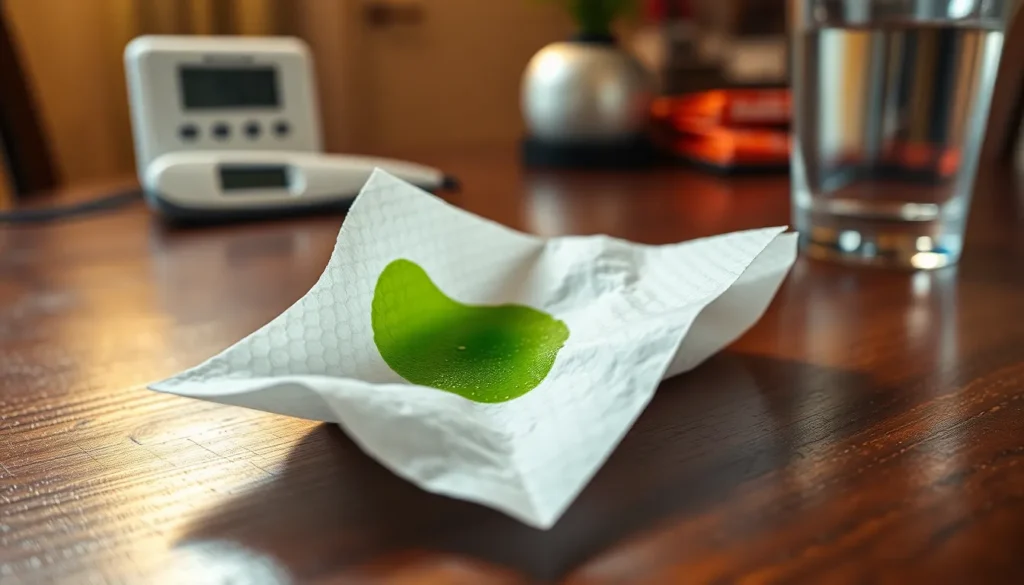Table of Contents
ToggleWhen it comes to mucus, most people don’t exactly think of it as a hot topic. But if you’ve ever blown your nose and found a vibrant shade of green staring back at you, you might’ve wondered if it’s time to panic or just grab a tissue. The truth is, green mucus can feel like a personal drama unfolding in your sinuses, and understanding what it really means could save you from unnecessary worry.
Is it a sign of infection or just your body’s way of getting creative? Spoiler alert: green mucus doesn’t always mean you’re headed for a doctor’s visit. Dive in as we unravel the mysteries behind that colorful nasal discharge, and discover whether you should be reaching for the tissues or just enjoying the show.
Understanding Mucus Color
Mucus color can provide insights into a person’s health, particularly when assessing respiratory function. Observing changes in mucus can help in identifying various conditions.
The Role of Mucus in the Body
Mucus serves as a protective barrier lining the respiratory, gastrointestinal, and reproductive tracts. This substance traps dust, bacteria, and pathogens, preventing them from entering the body. Mucus also keeps tissues hydrated, ensuring optimal function. Increased production often occurs during illness, as the body responds to infections or irritants. Such changes in mucus consistency and amount can signal the immune system’s activity.
Common Colors of Mucus and Their Significance
Mucus presents in various colors, each indicating specific health conditions. Clear mucus suggests a healthy state, while cloudy white indicates an early stage of infection. Yellow mucus often points to a stronger immune response, typically associated with infection. Green mucus can signal a more prolonged infection, often due to the presence of white blood cells. Brown or red mucus may indicate dried blood or a serious condition, warranting further attention. Understanding these colors helps individuals gauge their health status effectively.
What Does Green Mucus Indicate?

Green mucus often suggests the presence of infection or inflammation, especially in the respiratory system. Understanding its causes can provide clarity.
Possible Causes of Green Mucus
Common causes include bacterial infections and sinusitis. A cold can also lead to changes in mucus color. Allergies might contribute to the presence of green mucus, as the body reacts to allergens. In some cases, environmental factors like pollution can exacerbate mucus production. Persistent green mucus might signal a need for medical evaluation, should other symptoms accompany it. Individuals with chronic respiratory issues may experience green mucus due to exacerbations or infections.
When to Seek Medical Attention
Medical attention becomes necessary when green mucus persists beyond a week. Accompanying symptoms such as fever or facial pain indicate a higher potential for serious infection. Difficulty breathing or chest pain warrants immediate evaluation. Experiencing blood in the mucus also requires prompt medical care. It’s advisable for individuals with compromised immune systems to consult a doctor with any significant changes in mucus color or consistency.
Implications of Infection
Green mucus often indicates infection or inflammation, particularly within the respiratory system. Understanding how infections affect mucus production is vital for assessing health status.
How Infections Affect Mucus Production
Infections trigger the immune response, leading to increased mucus production. Fluids rush in to combat pathogens, causing mucus to thicken and change color. Mucus also traps bacteria and viruses, helping to clear the airways. Changes in color, such as green, can suggest the body is actively fighting an infection. The degree of inflammation can determine the amount and consistency of mucus as well. Increased mucus often leads to congestion and discomfort.
Differentiating Between Viral and Bacterial Infections
Recognizing whether an infection is viral or bacterial can clarify treatment options. Viral infections commonly cause clear or slightly cloudy mucus, whereas bacterial infections often result in green or yellow mucus. Symptoms accompanying green mucus, like fever or facial pain, may indicate a bacterial infection. A healthcare professional may recommend antibiotics if a bacterial infection is suspected. Viral infections typically resolve on their own, requiring supportive care instead. Understanding these distinctions can aid individuals in managing their health effectively.
Home Remedies and Treatments
Home remedies offer effective options for managing green mucus. Many individuals find relief through simple methods that support the body’s natural healing process.
Natural Remedies for Green Mucus
Steam inhalation provides moisture to the airways, which helps thin mucus. Adding essential oils, such as eucalyptus or peppermint, can enhance this effect. Warm compresses applied to the face promote sinus drainage and reduce discomfort. Staying hydrated by drinking ample fluids is crucial, as clear fluids, herbal teas, and broths can loosen mucus. Consuming honey and lemon in warm water may soothe the throat and has natural antibacterial properties. Spicy foods, containing ingredients like chili peppers, can also help clear nasal passages, promoting easier breathing.
Over-the-Counter Options
Several over-the-counter products effectively manage symptoms associated with green mucus. Decongestants are commonly used to reduce nasal swelling and congestion, promoting clearer airflow. Antihistamines can help alleviate mucus production caused by allergies. Expectorants, such as guaifenesin, assist in thinning mucus, making it easier to expel. Nasal sprays containing saline provide relief by moisturizing nasal passages. Always follow dosage instructions and consult a healthcare provider when unsure about treatment options.
Understanding the implications of green mucus can empower individuals to make informed health decisions. While it often signals infection or inflammation in the respiratory system, it’s essential to consider accompanying symptoms and overall health. Persistent green mucus, especially with fever or facial pain, may warrant medical attention.
By recognizing the different colors of mucus and their meanings, individuals can better assess their health status. Home remedies and over-the-counter treatments can provide relief, but knowing when to seek professional help is crucial. Staying informed and attentive to changes in mucus can lead to more effective management of respiratory health.



